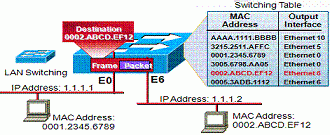Difference Between Layer 3 Switching and Routing
Layer 3 switches tend to have packet switching throughputs in the millions of packets per second (pps), while traditional general-purpose routers have evolved from the 100,000 pps range to over a million pps. Aggregate performance is one of the key differences between Layer 3 switches and traditional routers. Traditional routers still offer key features used typically in WAN environments. However, many of those features, such as multicast routing, multiprotocol routing, IBM feature sets, routing protocol stability, are still key for Layer 3 switches/campus routers.
A Layer 3 or a Layer 2 Switch?— Scalability Advantages
Let’s look more closely at when a customer might choose a Layer 3 switch over a traditional Layer 2 switch. Layer 3 switches offer considerable advantages depending on the customer’s requirements.
Scalability— For customers with large networks that need increased performance to handle the changing traffic patterns of today’s new applications, Layer 3 switches offer increased scalability. Clearly a network of hubs does not scale. While bridges helped, they were not sufficient to handle networks of many thousands of users and devices. Routers were the solution as they kept broadcasts local to a segment. Layer 3 switches avoid the problems associated with flat bridged or switched designs using traditional routing mechanisms allowing customers to scale their network infrastructure.
Layer 3 switches also utilize routing protocols thus avoiding the slow convergence problem of Spanning Tree Protocol and lack of load-balancing across multiple paths.
Advanced services— Layer 3 switches also offer the benefit of broader intelligent network services. These services permit applications to run on the network as well as enable the creation of a cost-effective, operational environment to support day-to-day operations and management of the enterprise intranet.
Other Advantages
Other advantages include:
Security—Layer 3 switches provide enhanced security functions to protect corporate information while allowing appropriate access. Access control lists are supported by Layer 3 switches with no performance degradation. Layer 3 switching is able to enforce the multiple levels of security traditionally only found on routers on every packet of the flow at wire speed.
Management—Networks that use a multilayer model are by nature hierarchical. This type of infrastructure is easier to manage as problems are more easily isolated.
Redundancy/resiliency—Some Layer 3 switches offer significant redundancy and resiliency options not available with Layer 2 switches. Default gateway redundancy is provided by HSRP that enables Cisco switches to transparently switch over to the hot standby backup router instantly when the primary router goes off line, eliminating a single point of failure in the network. UplinkFast provides alternative paths when a primary link fails. Load balancing is achieved by intelligent Layer 3 routing protocols.
While there are obvious advantages to a Layer 3 switch over a Layer 2 switch, other factors needed to be considered as well. Layer 3 switches are more expensive than Layer 2 switches and are more complex. Depending on the size of a customer’s network, the cost and complexity may not justify a Layer 3 switch. However, for customers with larger networks in need of enhanced scalability, Layer 3 switches will actually simplify network infrastructure.
Not All Layer 3 Switches Are Created Equal
At its most basic, Layer 3 packet switching or forwarding is common across all vendors platforms, with perhaps exceptions in their multicast or DHCP services behavior.
The more scalable, flexible, and adaptable Layer 3 switches also offer a variety of routing protocols and services for topology discovery, load balancing, and resiliency. Buying a Layer 3 switch without the richness and depth of routing protocols is somewhat akin to a driverless car. The car can certainly travel very fast in the direction that it is pointed, but the intelligence lies in the driver, who needs to make all the decisions about where it should go and when to stop and turn. The more flexible and resilient these capabilities, the better reliability and adaptability the switch offers.
Finally, there are services. All the queuing, filtering, classification, multiprotocol, route summarization and redistribution functions, plus additional debugging, statistics gathering and event logging services is what lets network managers deploy solutions that rise to the future challenges of mobility, multiservice, multimedia, and service level agreements for business critical applications.
– Summary –
- Layer 3 switching is ASIC-based routing
- Traditional routers are better for WAN aggregation
- Layer 3 switches are more appropriate for scaling Layer 3 performance
- Layer 2 switches are more appropriate when the additional cost and complexity are not warranted


